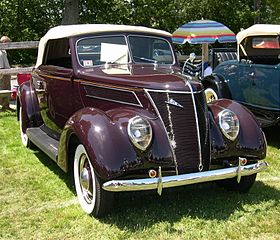| 1937 Ford | |
|---|---|
 1937 Ford convertible | |
| Overview | |
| Manufacturer | Ford |
| Production | 1937–1940 |
| Assembly | Atlanta, Georgia Chester, Pennsylvania Chicago, Illinois Long Beach, California Dearborn, Michigan Riga, Latvia Bucharest, Romania |
| Body and chassis | |
| Class | Full-size Ford |
| Body style | 2-door coupe 2-door convertible 2-door 1-ton pickup truck 2-door sedan 2-door station wagon 2-door van 4-door sedan 4-door station wagon (Woodie) 2-door coupe utility (Australia) [1] 2-door roadster utility (Australia) [1] |
| Layout | FR layout |
| Powertrain | |
| Engine | 136 CID (2.2 L) Flathead V8 221 CID (3.6 L) Flathead V8 |
| Transmission | 3-speed sliding-mesh manual |
| Dimensions | |
| Wheelbase | 2,845 mm (112.0 in) |
| Chronology | |
| Predecessor | Ford Model 48 |
| Successor | 1941 Ford |
The Ford line of cars was updated in 1937 with one major change — the introduction of an entry-level 136 cu in (2.23 L) V8 in addition to the popular 221 cu in (3.62 L) flathead V8. The model was a refresh of its predecessor, the Model 48 (itself based on the Model 40A) and was the company's main product. It was redesigned more thoroughly in 1941. At the start of production, it cost US$850 ($18,015 in 2023 dollars [2]). The Ford Line bore several model numbers during this period, each related to their respective HP numbers. In 1937, 85 HP cars were known as Model 78 while 60 HP cars were known as Model 74. This changed to Model 81A and 82A respectively in 1938, and Models 91A and 92A in 1939.
- ^ a b 1938 Ford V8 Utility Sales Brochure, www.ebay.com.au, as archived at web.archive.org
- ^ 1634–1699: McCusker, J. J. (1997). How Much Is That in Real Money? A Historical Price Index for Use as a Deflator of Money Values in the Economy of the United States: Addenda et Corrigenda (PDF). American Antiquarian Society. 1700–1799: McCusker, J. J. (1992). How Much Is That in Real Money? A Historical Price Index for Use as a Deflator of Money Values in the Economy of the United States (PDF). American Antiquarian Society. 1800–present: Federal Reserve Bank of Minneapolis. "Consumer Price Index (estimate) 1800–". Retrieved February 29, 2024.